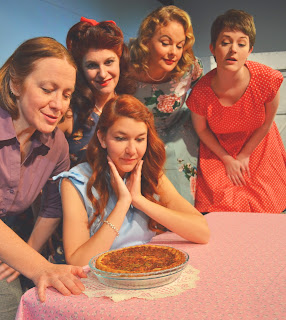By Alec Clayton
Published in The News Tribune, June 2,
2017
 |
GARY CHAMBERS (The Major General) and the Pirates from the Lakewood Playhouse Production of The Pirates of Penzance, photo by Tim Johnson
|
I reviewed “The
Pirates of Penzance” at Lakewood Playhouse 10 years ago. Now it’s back with a
new and quite different production with an all new cast and director. The
earlier production was directed by Barry Johnson, a director with extensive
experience directing opera. It was produced in a classic style with an emphasis
on the operatic aspects of the Gilbert and Sullivan musical.
This newer
version is directed by John Munn, who has a broad theatrical background
including acting in and directing comedies, dramas, and musicals – even
including “Pirates of Penzance.” Munn’s version weighs in more heavily on the
comic aspects and the physicality. Not that the singing isn’t good, it is, but it
is less operatic and more like “Monty Python” or a Warner Brothers cartoon,
which is pointed out in the promotional material.
There are also sly references
to “The Complete Works of William Shakespeare (Abridged)” and to other plays
and pop-culture icons, some of which only some folks will get and others of a
more personal nature that nobody would get, such as pirates climbing a ladder
into the audience in tribute to Tim Burton whose version of “Pirates” the
director saw in his youth.
In addition to
directing, Munn plays the Pirate King. This was not his intention. He did not
want the burden and huge challenge of both directing and playing a lead role,
but circumstances made it necessary, and he is so good in the part that I can’t
imagine anyone else in the role. His commanding presence, his comic timing, his
singing, and his acrobatic physicality are astounding.
 |
(L to R) FUNE TAUTALA (Fredric) and ALLYSON JACOBS-LAKE (Mabel) from the Lakewood Playhouse Production of The Pirates of Penzance, photo by Tim Johnson
|
Also
outstanding are Gary Chambers, a veteran of many Lakewood Playhouse
performances, as the loveable Major-General Stanley and Fune Tautala in his
Lakewood Playhouse debut as Frederic.
Standout
performances are also turned in by Kathy Sawrey as Ruth and Allyson Jacobs-Lake
as the love interest, Mabel. Both Sawrey and Jacobs-Lake sing clearly and
sweetly, and each plays her part as a complex and multi-faceted character.
Derek Hall as
the police sergeant is a comic treasure. He looks like Ringo Starr and moves
like Charlie Chaplin. All of the policemen are amazing in their almost
gravity-defying movements (choreographed by Amanda Jackson). The same can be
said of the rest of the ensemble cast, the pirates and the many daughters of
the Major-General. These ensemble groups are great singing in chorus. The
choral singing, in fact, outshines most of the solo singing. The groups of
policemen and pirates move almost as a single entity, and yet each policeman
and pirate and daughter is a distinct individual.
Ruth, at 47, is
the only woman 21- year-old Frederic has ever seen. He believes she is
beautiful because she says she is. And then he sees the many daughters and
discovers real beauty and falls in love with Mabel. But he can’t have her
because he is indentured to the pirates until his 21st birthday,
which will not arrive until he is 64 because he was a leap year baby. It might
be the most absurd plot device ever devised, but it’s funny, and that’s what
matters.
This version of
“The Pirates of Penzance” is a musical laughathon.
One other note
of interest: There is a recessed orchestra pit in the middle of the stage, and
actors move all around the three-piece orchestra, two pianos and a drum set,
with Musical Director Deborah Armstrong playing one of the pianos and
occasionally – and hilariously – breaking the fourth wall to direct and
interact with the actors. This is something I’ve never seen anywhere. It brings
down the house.
Opening night
was sold out and tickets are going fast, so get yours as soon as possible.
The Pirates of Penzance
WHEN: 8 p.m.
Thursday-Saturday, 2 p.m. Sunday, through June 25
WHERE: Lakewood Playhouse, 5729 Lakewood
Towne Center Blvd., Lakewood TICKETS: $25-$30
INFORMATION: 253.588.0042,
www.lakewoodplayhouse.org















